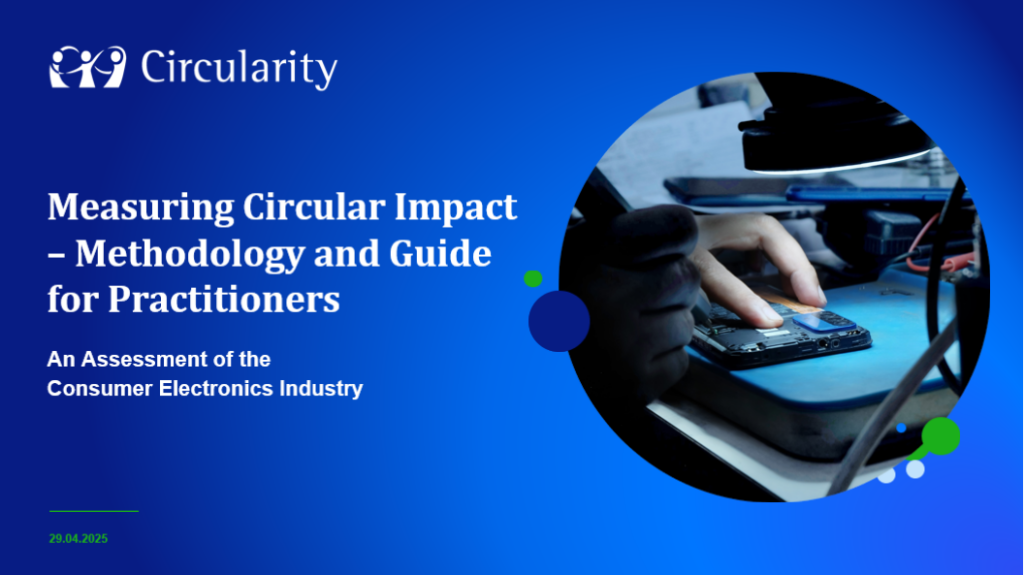Methodology and Guide for Practitioners

Germany could avoid 2-3 million new smartphones every year – new methodology demonstrates potential impact of circular business models
Berlin, April 29, 2025 – Circularity, the Do-Tank for the circular economy, today published their industry practitioner report on “Measuring Circular Impact“, unveiling a comprehensive methodology to assess the environmental impact of circular business models. Developed by Circularity in collaboration with 12 leading industry partners (Vodafone, Telekom, Assurant, rebuy, Grover, FixFirst, re!commerce, Foxway, Ingram Micro Lifecycle, Reverse Logistics Group, circulee, Everphone), as well as Systemiq, Fraunhofer IZM, and Deloitte, the report shows how circular models such as second-hand sales and rental services can significantly reduce environmental impact.
Based on a combination of operational data provided by the industry partners and market studies conducted by Circularity, the Circular Business Modell Impact (CBMI) methodology reflects real usage patterns, purchasing decisions by B2C & B2B consumers, as well as realistic company decisions with regards to fleet management, refurbishment & repair and resale of devices.
“What makes the CBMI method unique is its grounding in real-world device usage,” says Marina Proske, Group Manager Life Cycle Modeling, Fraunhofer IZM. “It allows companies to move beyond assumptions and act on measurable outcomes.”
A broken system – are circular business models the solution?
In Germany, only 14% of smartphones and laptops in circulation are second-hand, repair rates remain low and just 30% of devices are formally recycled – causing valuable resources like rare earth elements, metals, and plastics to be lost instead of being recirculated.
“The electronics sector is still deeply linear,” says Manuel Braun, Senior Director, Systemiq. “But with the right incentives, circular models can help us close resource loops at scale. What’s been missing is a clear view of how devices actually move through the system. The Systems Map in this report provides exactly that – offering a shared baseline to understand where interventions are most needed.”
Circular business models offer a potential solution – by recirculating products for as long as technically possible. Until now, companies, investors and policymakers have lacked practical tools to measure the real environmental impact of circular models – especially across multi-user life cycles. Existing frameworks like the GHG Protocol capture these dynamics only in limited ways.
“The CBMI methodology fills a critical gap in sustainability measurement,” says Carolin Schmid, Deloitte Topic Lead Customer Strategy in Circularity. “By focusing on the actual use phase, the impacts of customer behavior become a central component in the evaluation. It enables a much more realistic assessment of circular strategies – especially in complex industries like electronics. As a result, companies, investors and policymakers finally have the means to track, compare, and scale effective circular solutions.”
The new method reveals when circular models work – and what holds them back
The report by Circularity addresses this gap by introducing the CBMI methodology focused on actual product use – including the net active use of devices, repair behavior, return rates, and resale decisions of B2C and B2B consumers – to help companies determine to what extent their circular models reduce emissions and resource use.
It shows, for example, that emissions from logistics and refurbishment account for only around 3% of a smartphone’s lifetime footprint – while extended use can reduce yearly emissions by up to 20%. Professional second-hand resale can extend the lifespan of a smartphone by up to 33% and cut annual CO₂ emissions by around 20%, while rental models typically increase lifespan by more than 17% and reduce emissions by approximately 11%. Rental especially reduces emissions of infrequently used devices’, like gaming consoles, by up to 19% through better utilization. In B2B contexts, refurbished smartphones for example can stay in active use for up to seven years and reduce annual emissions by up to 20%.
“We see massive untapped potential in the devices already out there,” says Dr. Paul Wöbkenberg, Co-Founder of Circularity. “Today, around 50% of privately owned and 70% of business devices are never reused—often not because of technical limits, but due to lack or unawareness of return options, low incentives or concerns about data security.”
“Circular business models hold great promise – but until now, it’s been difficult to measure their true environmental impact,” adds Dr. Marianne Kuhlmann, Co-Founder of Circularity. “This report gives companies the tools to move from assumptions to evidence – and to design models that really make a difference. It also highlights practical levers that companies can act on to reduce emissions and extend product use.”
